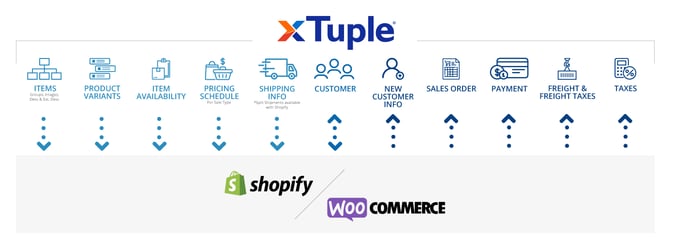
End-to-End Solutions for E-commerce
xTuple isn’t trying to solve the problems of companies who have already transitioned to an ERP system that cost upwards of $100K and took a year to implement. They have our condolences, but they aren’t “our people.” Our people are scrappy manufacturers and distributors that are killing it through hard work, great products and people and that simply haven’t yet been able to leverage operations management technology to get to the next level of growth.
For nearly 20 years, xTuple has helped our people grow to the next level no matter what their lifecycle stage. We’ve done that by A) listening to our customers, B) watching the market, and C) running everything we do through a filter of customer success. We ask the right questions to make sure that the answers and by extension products we develop provide real solutions. And for the record, we only believe something is a “real solution” if it is accessible – meaning: affordable, simple to implement and easy to use.
The next in a series of initiatives designed to help our customers drive sustainable growth and profitability is xTuple E-commerce Solutions. Today, with this product release, we introduce the first in a series of integrations to help manufacturers sell more of their stuff. We’re already helping them make more, now we’re facilitating their ability to move more.
xTuple is focused on providing the platform and tools to help companies achieve sustainable growth and profitability, whatever form that make take. We understand it is not as easy or as simple as it sounds: just start selling online, here’s your shopping cart. However, we do know that you can make an informed decision if you ask the right questions, go into it with a clear strategy and leverage the right technology, the benefits and rewards of adding online sales to your business model are great. But as the old adage goes where there is great reward, there is also risk. Mitigating risk is always easier when you ask the right questions and take a strategic approach.
Be fearless, not reckless.
Don’t reinvent the wheel, leverage it! Start by understanding your goals and needs.
Questions: What will you be selling online? Are you moving excess inventory or creating a product specifically for online sales?
Questions: Where / how will you sell? Will you sell via retail or wholesale sites? Direct, multi-vendor sites or both? Will you place/post products yourself or through a multi-channel platform?
To Amazon or not to Amazon, that is the question.
Or is it? The question really is: why wouldn’t you sell online? And not just through Amazon but direct or through the multitude of effective online marketplaces that reach your specific end-users. One of the many great things about modern technology markets is that the choice for manufacturers on sales channels is nearly infinite. The options are bigger than either selling to wholesalers or directly to retailers. And the old rules don’t necessarily apply.
Most manufacturers have plenty of “war stories” (and wounds) related to dealing with onerous Big Box retailers, wholesalers and rep firms. Where brick-and-mortar was once king, today Amazon, eBay, Grainger, Newegg, Wayfair and a slew of other multi-seller marketplaces have created an opportunity for manufacturers that even ten years ago didn’t exist and weren’t as turnkey as they are now.
Manufacturers no longer have to put their eggs in a single basket and rely on others to move their products -- unless they want to and it makes the most sense for their business model. But whether you’re selling your products online or not, someone else is – now you have the choice to control it. Assuming there are no issues in your reseller agreements, the benefits of selling directly are exponential.
Most importantly, selling directly to consumers gives you more control over your brand, price and insight into (and relationship with) your customer. Strategically and tactically, selling direct gives manufacturers many advantages.
The opportunities are endless. If we take no other lesson from the pandemic, we know that selling online and leveraging technology to streamline the process from production to end-user can be the difference between surviving and thriving.
Set up for success.
Once you understand why and what, you can focus on how. The following are key considerations for expanding your sales to include e-commerce from a very high level. We hope the following will help you kick off your exploration of adding online sales to your business model.
Question: Do you have the infrastructure to support direct sales?
Start with the basics; the key considerations that will inform your decision on 1) whether you should / can sell online; 2) what it will take to get you up and running; and 3) a realistic timeline. The following are key considerations in no particular order as they are equally important, starting with how will you deliver?
Order fulfillment and tracking. Do you have the ability to drop ship? Can you provide delivery updates in real-time?
If you don’t immediately have the ability to ship direct to customers, identify and vet third-party providers – there are many great alternatives to altering your entire operation. If you decide to use Fulfillment by Amazon (FBA), make sure you understand their fees. Also, keep in mind you don’t need to sell through Amazon to use FBA, however, they won’t fulfill Walmart orders. There are many options for third-party fulfillment that can get you up and running quickly without revamping your shipping area and processes.
And here is a fun fact: selling on Amazon using FBA gives sellers on average a 30% - 50% increase in sales. (Source)
How will you secure payments?
Your ERP and/or shopping cart software should include a solution. xTuple is integrated with Authorize.Net and Stripe directly, and also Shopify and WooCommerce, which provide payment processing. Should you decide to strictly sell on multi-channel platforms a secure payment portal should be included and when listing on marketplaces such as Amazon or Walmart, the marketplace assumes the risk for fraudulent transactions.
Customer Service. Do you have the infrastructure to manage customers – from returns to reviews? How will you support the customer experience?
In the age of the review, sellers live and die by the customer experience. An internal team or third-party partner experienced with the specific channels you select can help make adding an online channel easier and ensure your customer service/support is locked and loaded. Responding immediately to unhappy buyers is key to overall rankings.
Sales & Marketing
As much as we all liked “Field of Dreams,” there is no such thing as “if you build it, they will come.” Whether you’re selling direct from your own e-commerce site, on a multi-vendor site or Amazon, just like in brick-and-mortar, you’re responsible for driving traffic to your site, products / listings. Have a budget. Employ best practices. Set your company apart.
Track. Measure. Analyze. Act! Regardless of the channel(s) you select, use the information you gather to inform decisions that impact your bottom line. When you’re selling directly to end-users – vs. to wholesalers/retailers – you have the ability to better understand behaviors, patterns, price sensitivity and much more thorough data to which you have unfiltered access in real-time. (Download our KPI White Paper for helpful information on financial and operations KPIs.)
If your site is designed to facilitate ordering for existing customers, make sure you’re managing your brand effectively, communicating opportunities and driving a user experience that enhances sales and reinforces your core values / message.
Will you sell B2B, B2C or both?
There are so many options to consider depending on your products. If you plan to sell both B2B and B2C, Amazon is a great option because you can post products both for the general public and for commercial purchase and use FBA. Sites like Grainger.com that specializes in the sale of maintenance, repair and operating products, manages sales for both commercial and individual use.
Whether you decide to sell through specialty or wholesales sites such as Grainer or Alibaba, or Grainger or you decide to sell on marketplaces such as Amazon, Rakuten or Walmart – or even specialty sites like TheRealReal or Medline - make sure the experience for your customers is consistent with every other touchpoint and that you’re selecting the channels that will give you the greatest return.
Leverage Technology
Leverage the right technology to manage the process from end-to-end ... from production to delivering to end-users. Manufacturers have very specific challenges, so finding the right platform to do it all is key. That’s why xTuple took our time to identify the best solutions for our customers and growing manufacturers that want to measure three times and cut once.
Integrating with both Shopify and WooCommerce provides simple options for xTuple customers moving to online sales adding the next level of functionality for growth to already robust accounting, inventory management, manufacturing and planning tools. For new users, xTuple provides an end-to-end solution to make, sell and ship more products.

xTuple has helped hundreds of companies grow from every stage of their lifecycle. This new release of integrations with leading providers - Shopify, WooCommerce and ShipStation – is just one more step xTuple is taking to help keep the supply chain moving.
When you’re ready to learn more, let our team show you how we can help you make it better.
More food for thought.
Whatever your goals for entering into the e-commerce space, these additional considerations are food for thought as you work determine the best strategy for your company.
Risk Factors
Be a good partner! Establish price guards for your wholesale/retail partners.
Don’t damage your brand! You want to maintain the experience for consumers. If you can’t manage the experience consistently and in a way that is going to enhance and build your brand, don’t expand into online sales until you’re ready to do it right! Make sure your website, customer service and all touch points make it easy for consumers to reach you.
Find the right channel for your product(s).
Direct (B2C) site. Here, customers interact directly with the online representation of your brand and you sell directly to them. The best upside is you get all the revenue and the data. But every upside has a downside, you assume all the risk – from driving traffic to fraudulent cards. So be sure you’re looking at the entire picture.
Marketplaces. Think of the marketplace as the mall – traffic is guaranteed. These include eBay and Walmart, or specialty sites like Newegg. One of the greatest upsides is that these marketplaces assume the risk for fraudulent transactions. The downside? Fees! There are monthly fees, transaction fees, commissions, etc. etc. etc. You shouldn’t let the fees deter you from marketplaces because if you’re selling direct from your own site, you’re going to have to pay for traffic. Understand the fee structures so you can make the best determination and remember, you don’t have to do one or the other.
If you use a multi-channel platform such as ChannelAdvisor, you can list your products on your direct site as well as on other marketplaces. In early 2021, xTuple will launch our integration with multi-channel platform ChannelAdvisor providing users with the ability list inventory across channels for greater reach and increased sales opportunities.
Additional key considerations when listing on marketplaces:
Amazon. There is a reason more than 197 million people around the world visit Amazon.com every month. In the U.S., 95 million people have Amazon Prime memberships. Why? Amazon is designed to motivate the buyer.
Key Pros
Key Cons
There are as many channels for selling your products as there are enterprise resource planning (ERP) systems. The most important thing you can do for your company is to find the one that is best for your business. Ask the right questions, look under the hood and make sure you have a clear path to success.
I invite you to look at our Products, Solutions, Resources and learn more about xTuple ERP.
Contact
xTuple
A CAI Software Company
24 Albion Rd, Suite 230
Lincoln, RI 02865
+1-757-461-3022
About
"xTuple" (verb) — to grow; to increase exponentially. Our mission is to help manufacturing and inventory-centric companies use management software and best practices to grow their business profitably.